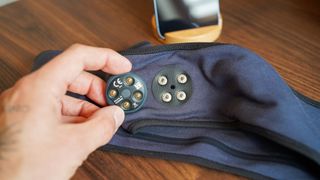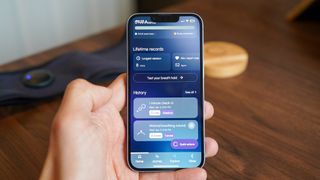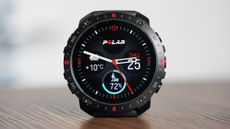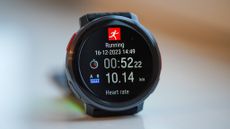Breathing, often overlooked, is a powerful form of self-care. It's not just free, but mastering proper breathing techniques can significantly reduce stress and boost overall health. While there are several wearables designed to enhance breathing, the Oxa Breathing Coach stands out as the sole device offering instant biofeedback. Intrigued, I decided to put it to the test!
As a person keen on improving their health with as little supplementation and medication as possible, I'm always on the lookout for new ways to enhance my sleep, mental health and breathing. Not surprisingly, all of these are connected and, under normal circumstances, cost nothing to better.
Sadly, we (I) haven't got much time to spend on mindfulness and meditation these days, so as eager as I am to do my sessions, I often end up skipping them so I can work or exercise more. Terrible behaviour, I know, but that's just how it is.
I expected the Oxa Breathing Coach to be similar to other devices I tried in the past: a little rough around the edges but backed by good intentions. To my surprise, Oxa offers a solid service backed by science (obviously), presented via a very handsome app.
It's a somewhat niche device in the sense that maybe not everyone will be able to justify spending the cash on a wearable that 'only' improves breathing and does nothing else. However, should you decide to invest in Oxa, it might just help you lead a bit more healthier lifestyle.
Oxa Breathing Coach review
Price and availability
The Oxa Breathing Sensor is available to buy now directly from Oxa US and Oxa UK for $249/ £229 (strap and sensor combo) – AU price and availability TBC.
There are also ‘shirt and sensor’ and ‘bra and sensor’ combo options available. Oxa also sells bras, straps and sensors separately.
Specifications
- Dimensions: 38 x 38 x 12.5 mm (1.5 x 1.5 x 0.5 in)
- Weight: 9 g (0.3 oz, sensor only)
- Connectivity: Bluetooth Low Energy; connects to Oxa app on Android and iOS
- Battery life: up to 27 hours
- Charging time (0-100%): 150-180 minutes
- Sensors: ECG, RIP, Infrared temperature, 3D accelerometer
- Durability: splash-proof
Design and comfort

The Oxa sensor is a tiny pod that clips onto either the strap, shirt or bra. It weighs only 9 g (0.3 oz.) and really isn’t much bigger than a large coin.
Despite its compact size, the pod houses several sensors, including an accelerometer and Oxa’s patented Geckto electrode, which helps the device measure ECG, heart rate, and heart rate variability.
Oxa is said to be the first and only wearable breathing exercise device that can provide a live breathing signal to the user, including inhales, exhales, breathing amplitude, breathholds, and breathing interruptions via the Respiratory Inductance Plethysmography (RIP) technology.
Initially, I used the sensor with a different strap that’s not available anymore, which was a soft, circular fabric. It was comfortable but required me to ‘step into’ it and put it on like a bra.
Since then, Oxa has launched a new version that functions like a heart rate monitor strap, allowing you to unclip it after each use. This is a welcome change, as my biggest grief was getting in and out of the thing. It’s an easy process using the new strap.
You don’t have to wear the Oxa sensor continuously like a smartwatch. Instead, you only put it on when you want to do a session, which I think is more appealing to most people. Many find it hard to wear smartwatches 24/7, but with the Oxa sensor, it won’t be an issue.
Charing is pretty simple; just unclip the sensor pod from the strap/shirt/bra, peel off the rubber ring, and pop the sensor on the charge. The process couldn’t be simpler. You can double-check the battery level in the app by tapping on the icon in the top right corner.
Oh, and one final thing: to turn on the sensor, you have to shake it gently. Usually, putting it on will shake the pod enough to turn on, but should it not, take it off and give it a wiggle. A blue light will pulsate on the pod when it’s awake.
Oxa app and features
The Oxa sensor is one thing, but the main attractions are the app and the exercises. I’m used to companion apps for similar devices being a clunky and definitely not as polished as the Oxa app.
It’s well laid out, making it easy to navigate. Exercises can be located quickly, and there is just enough gamification to keep you going without it taking centre stage. On your dashboard, you can see all your key stats, including your lifetime records.
The exercises are excellent, too. Usually, you’ll see a pulsating ring, and depending on the task, you either have to keep up with its movement or perform other tasks to synchronise them, to mention a couple.
There is also voice guidance, not to mention the other sounds played during your sessions, all working together to create a fluid, engaging experience. Exercises vary in length. Some are short, one-minute bursts, while others can go on for over 10 minutes.
The variety is impressive, too. You get the standard ‘check-in’ style exercises, and you can also choose a path (MInd or Body) under the Journey tab, which will present you with breathing exercises focused on that topic.
The Explore tab offers yet more options, from exercises to calm you down after work to sessions for sleep, focus, and more.
Of course, it’s all breathing, but you’d be surprised how much variety there is with different breathing techniques.
Feedback is instantaneous, which helps you keep the rhythm going. Only during structured workouts, I got a bit annoyed. At the end of a block, I kept going with my eyes closed (as requested by the app) because the app didn’t really make it clear that my input was required to move the session forward.
It’s a minor grievance; as a whole, the combination of sounds, voice and visual guidance is more than enough to keep you on track.
Verdict

I enjoyed using the Oxa Breathing Coach. It’s one of the few wearables I’ll be sad to return at the end of the loan period, mainly because the tangible benefits it offers. Breathing might come naturally to most, but should it be done correctly, it can also improve health and reduce stress. And using Oxa can teach you how to breathe right in a fun and engaging way.
Of course, the price is a slight issue, but bear in mind that the app doesn’t cost anything; you only have to pay the lump sum for the hardware, while the rest of the service is free. If you live a particularly hectic life, I’d recommend giving the Oxa Breathing Coach a try.
Also consider
Follwing a similar, app-based approach, the Airofit Pro 2.0 promises enhanced features like advanced lung function measurement and improved feedback. Despite minor issues like Bluetooth connectivity, it's a valuable tool for athletes and anyone seeking better lung health. With just 5-10 minutes of daily training, users can boost lung capacity and reduce heart rate, making it a worthwhile investment.












